If the name "Google Webmaster Tools" rings a bell for you, then you might already have an idea of what Google Search Console is. Since Google Webmaster Tools (GWT) has become a valuable resource for so many different types of people besides webmasters—marketing professionals, SEOs, designers, business owners, and app developers, to name a few—Google decided to change its name in May of 2015 to be more inclusive of its diverse group of users.
If you aren't familiar with GWT or Google Search Console, let's head back to square one. Google Search Console is a free service that lets you learn a great deal of information about your website and the people who visit it. You can use it to find out things like how many people are visiting your site and how they are finding it, whether more people are visiting your site on a mobile device or desktop computer, and which pages on your site are the most popular. It can also help you find and fix website errors, submit a sitemap, and create and check a robots.txt file.
Ready to start taking advantage of all that Google Search Console has to offer? Let's do this.
Adding and verifying a site in Google Search Console
If you're new to Google Search Console, you'll need to add and verify your site(s) before you can do anything else. Adding and verifying your site in Search Console proves to Google that you're either a site's owner, webmaster, or other authorized user. After all, Search Console provides you with all sorts of incredibly detailed information and insights about a site's performance. Google doesn't want to hand that kind of information over to anybody who asks for it.
Adding a site to Search Console is a very simple process. First, log into your Search Console account. Once you're logged in, you'll see a box next to a red button which says "Add Property."

Enter the URL of the site you're trying to add in the box and click "Add Property." Congratulations, your site is now added to your Search Console account!
Next, you will be asked to verify your site. There are a few different ways you can go about this. Which method will work best for you depends on whether or not you have experience working with HTML, if you have access to upload files to the site, the size of your site, and whether or not you have other Google programs connected to your site. If this sounds overwhelming, don't worry—we'll help you figure it out.
Adding an HTML tag
This verification method is best for users and site owners who have experience working with HTML code.

From the Search Console dashboard, select "Manage Property," then "Verify this property." If the "HTML Tag" option does not appear under "Recommended method," then you should click on the "Alternate methods" tab and select "HTML tag." This will provide you with the HTML code you'll need for verification.
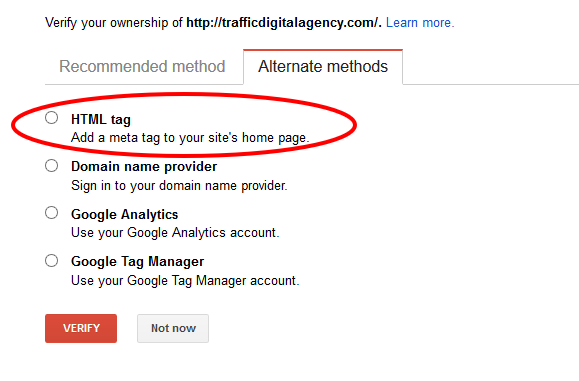
Copy the code and use your HTML editor to open the code for your site's homepage. Paste the code provided within in the <Head> section of the HTML code. If your site already has a meta tag or other code in the <Head> section, it doesn't matter where the verification code is placed in relation to the other code; it simply needs to be in the <Head> section. If your site doesn't have a <Head> section, you can create one for the sake of verifying the site.
Once the verification code has been added, save and publish the updated code, and open your site's homepage. From there, view the site's source code. The verification code should be visible in the <Head> section.
Once you're sure the code is added to your site's homepage, go back to Search Console and click "Verify." Google will then check your site's code for the verification code. If the code is found, you will see a screen letting you know the site has been verified. If not, you will be provided with information about the errors it encountered.
When your site has been verified by Search Console, do not remove the verification code from your site. If the code is removed, it will cause your site to become unverified.
Uploading an HTML file
To use this method, you must be able to upload files to a site's root directory.
From the Search Console dashboard, select "Manage site," then "Verify this site." If "HTML file upload" is not listed under "Recommended method," it should be listed under the "Alternate method" tab. 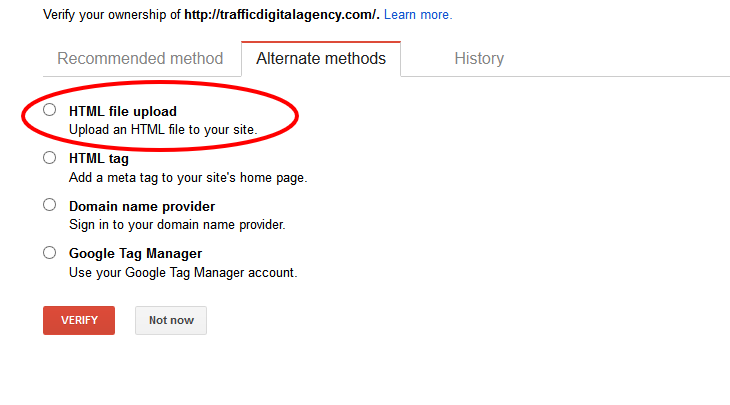
When you select this method, you will be asked to download an HTML file. Download it, then upload it to the specified location. Do not make any changes to the content of the file or the filename; the file needs to be kept exactly the same. If it is changed, Search Console will not be able to verify the site.
After the HTML file has been uploaded, go back to Search Console and click "Verify." If everything has been uploaded correctly, you will see a page letting you know the site has been verified.
Once you have verified your site using this method, do not delete the HTML file from your site. This will cause your site to become unverified.
Verifying via domain name provider
The domain name provider is the company you purchased a domain from or where your website is hosted. When you verify using your domain name provider, it not only proves you're the owner of the main domain, but that you also own all of the subdomains and subdirectories associated with it. This is an excellent option if you have a large website.
From the Search Console dashboard, select "Manage site," then "Verify this site." If you don't see the "Domain name provider" option listed under "Recommended method," look under the "Alternate method" tab.
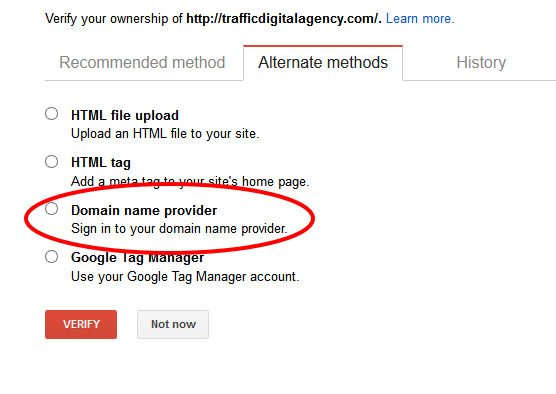
When you select "Domain name provider," you will be asked to choose your domain name provider from a list of commonly used providers, such as GoDaddy.com. If your provider is not on this list, choose "Other" and you will be given instructions on how to create a DNS TXT record for your provider. If a DNS TXT record doesn't work for your provider, you will have the option of creating a CNAME record instead.
Adding Google Analytics code
If you already use Google Analytics (GA) to monitor your site's traffic, this could be the easiest option for you. But first, you'll need to be able to check the site's HTML code to make sure the GA tracking code is placed within the <Head> section of your homepage's code, not in the <Body> section. If the GA code is not already in the <Head> section, you'll need to move it there for this method to work.
From the Search Console dashboard, select "Manage site," then "Verify this site." If you don't see the "Google Analytics tracking code" option under the "Recommended method," look under the "Alternate method" tab. When you select "Google Analytics tracking method," you'll be provided with a series of instructions to follow.
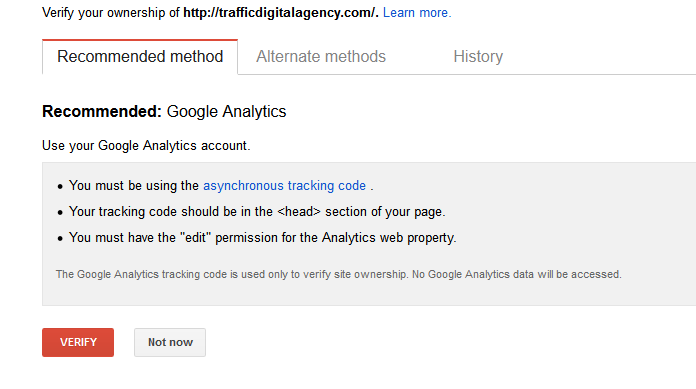
Once your site has been verified, do not remove the GA code from your site, or it will cause your site to become unverified.
Using Google Tag Manager
If you already use Google Tag Manager (GTM) for your site, this might be the easiest way to verify your site. If you're going to try this method, you need to have "View, Edit, and Manage" permissions enabled for your account in GTM. Before trying this method, look at your site's HTML code to make sure the GTM code is placed immediately after your site's <Body> tag.
From the Search Console dashboard, select "Manage site," then "Verify this site." If you don't see the "Google Tag Manager" option listed under "Recommended method," it should appear under "Alternate method."
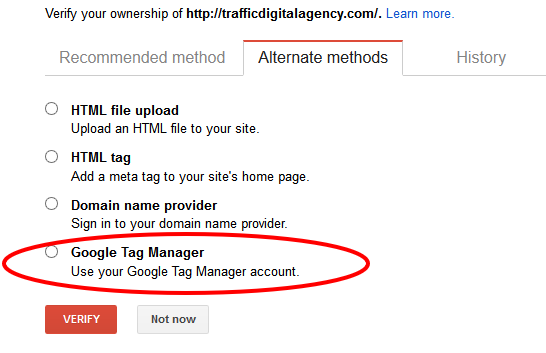
Select "Google Tag Manager" and click "Verify." If the Google Tag Manager code is found, you should see a screen letting you know your site has been verified.
Once your site is verified, do not remove the GTM code from your site, or your site will become unverified.
How to link Google Analytics with Google Search Console
Google Analytics and Google Search Console might seem like they offer the same information, but there are some key differences between these two Google products. GA is more about who is visiting your site—how many visitors you're getting, how they're getting to your site, how much time they're spending on your site, and where your visitors are coming from (geographically-speaking). Google Search Console, in contrast, is geared more toward more internal information—who is linking to you, if there is malware or other problems on your site, and which keyword queries your site is appearing for in search results . Analytics and Search Console also do not treat some information in the exact same ways, so even if you think you're looking at the same report, you might not be getting the exact same information in both places.
To get the most out of the information provided by Search Console and GA, you can link accounts for each one together. Having these two tools linked will integrate the data from both sources to provide you with additional reports that you will only be able to access once you've done that. So, let's get started:
Has your site been added and verified in Search Console? If not, you'll need to do that before you can continue.
From the Search Console dashboard, click on the site you're trying to connect. In the upper righthand corner, you'll see a gear icon. Click on it, then choose "Google Analytics Property."

This will bring you to a list of Google Analytics accounts associated with your Google account. All you have to do is choose the desired GA account and hit "Save." Easy, right? That's all it takes to start getting the most out of Search Console and Analytics.
Adding a sitemap
Sitemaps are files that give search engines and web crawlers important information about how your site is organized and the type of content available there. Sitemaps can include metadata, with details about your site such as information about images and video content, and how often your site is updated.
By submitting your sitemap to Google Search Console, you're making Google's job easier by ensuring they have the information they need to do their job more efficiently. Submitting a sitemap isn't mandatory, though, and your site won't be penalized if you don't submit a sitemap. But there's certainly no harm in submitting one, especially if your site is very new and not many other sites are linking to it, if you have a very large website, or if your site has many pages that aren't thoroughly linked together.
Before you can submit a sitemap to Search Console, your site needs to be added and verified in Search Console. If you haven't already done so, go ahead and do that now.
From your Search Console dashboard, select the site you want to submit a sitemap for. On the left, you'll see an option called "Crawl." Under "Crawl," there will be an option marked "Sitemaps."
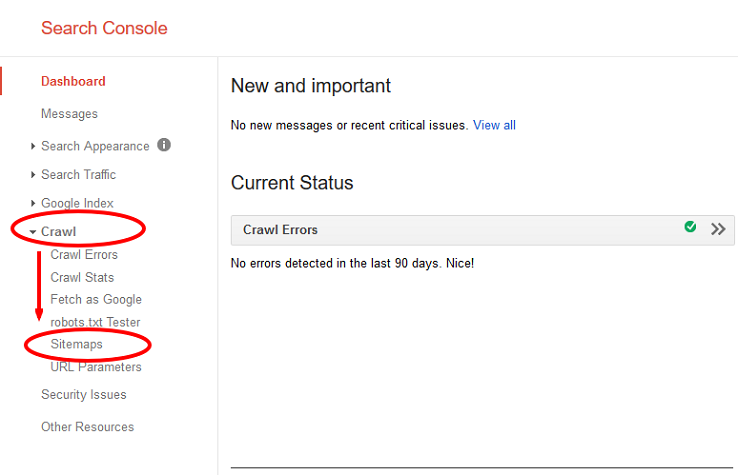
Click on "Sitemaps." There will be a button marked "Add/Test Sitemap" in the upper righthand corner.
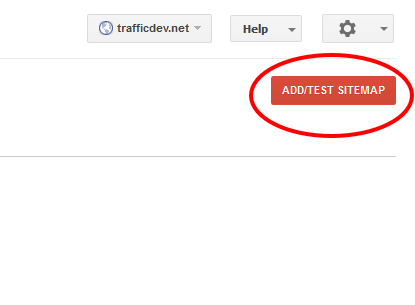
This will bring up a box with a space to add text to it.
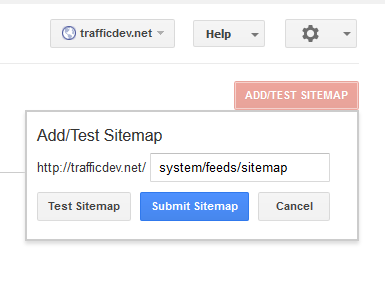
Type "system/feeds/sitemap" in that box and hit "Submit sitemap." Congratulations, you have now submitted a sitemap!
Checking a robots.txt file
Having a website doesn't necessarily mean you want to have all of its pages or directories indexed by search engines. If there are certain things on your site you'd like to keep out of search engines, you can accomplish this by using a robots.txt file. A robots.txt file placed in the root of your site tells search engine robots (i.e., web crawlers) what you do and do not want indexed by using commands known as the robots Exclusion Standard.
It's important to note that robots.txt files aren't necessarily guaranteed to be 100% effective in keeping things away from web crawlers. The commands in robots.txt files are instructions, and although the crawlers used by credible search engines like Google will accept them, it's entirely possible that a less reputable crawler will not. It's also entirely possible for different web crawlers to interpret commands differently. Robots.txt files also will not stop other websites from linking to your content, even if you don't want it indexed.
If you want to check your robots.txt file to see exactly what it is and isn't allowing, log into Search Console and select the site whose robots.txt file you want to check. Haven't already added or verified your site in Search Console? Do that first.
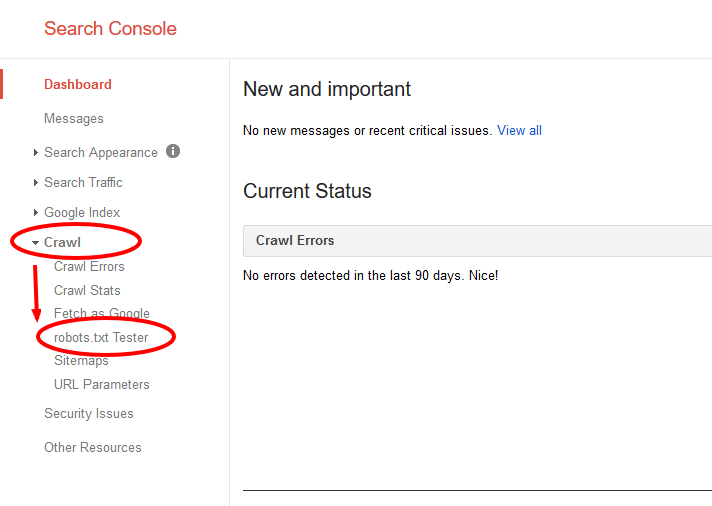
On the lefthand side of the screen, you'll see the option "Crawl." Click on it and choose "robots.txt Tester." The Robots.txt Tester Tool will let you look at your robots.txt file, make changes to it, and it alert you about any errors it finds. You can also choose from a selection of Google's user-agents (names for robots/crawlers) and enter a URL you wish to allow/disallow, and run a test to see if the URL is recognized by that crawler.
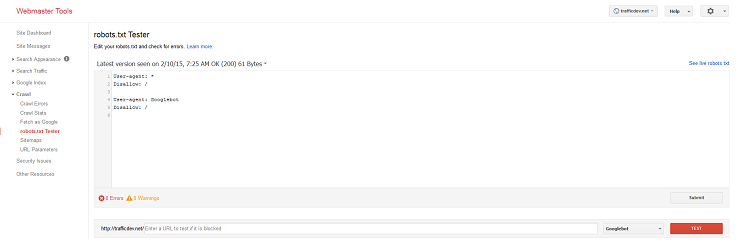
If you make any changes to your robots.txt file using Google's robots.txt tester, the changes will not be automatically reflected in the robots.txt file hosted on your site. Luckily, it's pretty easy to update it yourself. Once your robots.txt file is how you want it, hit the "Submit" button underneath the editing box in the lower righthand corner. This will give you the option to download your updated robots.txt file. Simply upload that to your site in the same directory where your old one was (www.example.com/robots.txt). Obviously, the domain name will change, but your robots.txt file should always be named "robots.txt" and the file needs to be saved in the root of your domain, not www.example.com/somecategory/robots.txt.
Back on the robots.txt testing tool, hit "Verify live version" to make sure the correct file is on your site. Everything correct? Good! Click "Submit live version" to let Google know you've updated your robots.txt file and they should crawl it. If not, re-upload the new robots.txt file to your site and try again.
Fetch as Google and submit to index
If you've made significant changes to a website, the fastest way to get the updates indexed by Google is to submit it manually. This will allow any changes done to things such as on-page content or title tags to appear in search results as soon as possible.
The first step is to sign into Google Search Console. Next, select the page you need to submit. If the website does not use the 'www.' prefix, then make sure you click on the entry without it (or vice versa.)
On the lefthand side of the screen, you should see a "Crawl" option. Click on it, then choose "Fetch as Google."
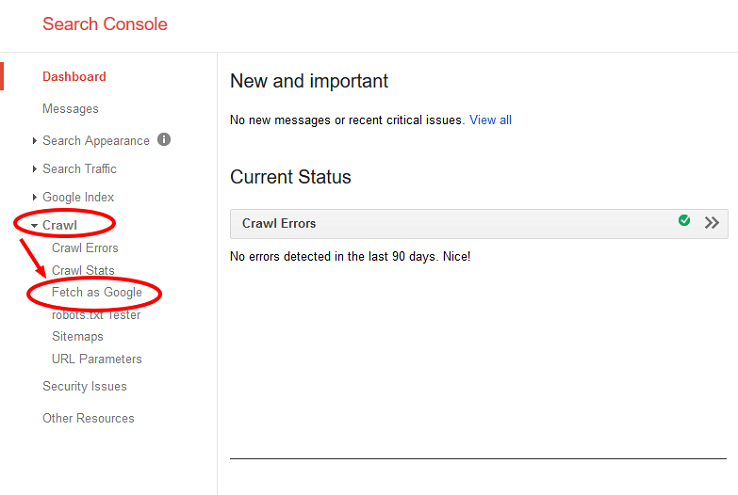
Clicking on "Fetch as Google" should bring you to a screen that looks something like this:

If you need to fetch the entire website (such as after a major site-wide update, or if the homepage has had a lot of remodeling done) then leave the center box blank. Otherwise, use it to enter the full address of the page you need indexed, such as https://example.com/category. Once you enter the page you need indexed, click the "Fetch and Render" button. Fetching might take a few minutes, depending on the number/size of pages being fetched.
After the indexing has finished, there will be a "Submit to Index" button that appears in the results listing at the bottom (near the "Complete" status). You will be given the option to either "Crawl Only This URL," which is the option you want if you're only fetching/submitting one specific page, or "Crawl This URL and its Direct Links," if you need to index the entire site.
Click this, wait for the indexing to complete, and you're done! Google now has sent its search bots to catalog the new content on your page, and the changes should appear in Google within the next few days.
Site errors in Google Search Console
Nobody wants to have something wrong on their website, but sometimes you might not realize there's a problem unless someone tells you. Instead of waiting for someone to tell you about a problem, Google Search Console can immediately notify you of any errors it finds on on your site.
If you want to check a site for internal errors, select the site you'd like to check. On the lefthand side of the screen, click on "Crawl," then select "Crawl Errors."

You will then be taken directly to the Crawl Errors page, which displays any site or URL errors found by Google's bots while indexing the page. You will see something like this:
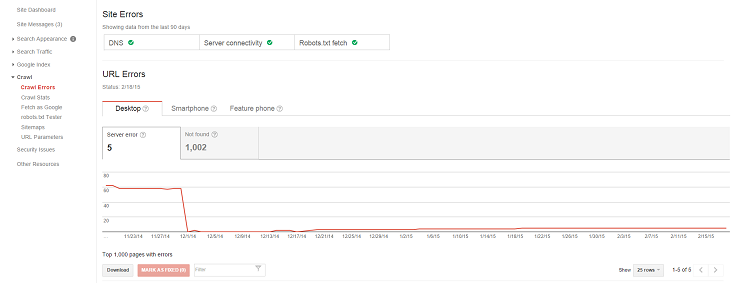
Any URL errors found will be displayed at the bottom. Click on any of the errors for a description of the error encountered and further details.

Record any encountered errors, including screenshots if appropriate. If you aren't responsible for handling site errors, notify the person who is so they can correct the problem(s).
We hope this guide has been helpful in acquainting you with Google Search Console. Now that everything is set up and verified, you can start taking in all the information that Google Search Console has for you.


Look as great explanation of basic Search Console (old WMT) tools.
I like most part of verification. It's in-depth describe whole process of verification assets step-by-step.
I have just one suggestion to author - can you wrote some in beginning that site can be seen on many ways to search engine robots:
https://www.example.com/
https://example.com/
https://www.example.com/
https://example.com/
and dependent of site/hosting configuration few of them need to be verified too. Also subsites as:
https://subsite1.example.com/
https://www.subsite2.example.com/
need to be verified independent from main site because search engines think that this is different site. Yes - they share same root domain (example.com) but second level domain and protocol are different.
It's great suggestion as a lot of people are not certain about the concept of property in Search Console.
That is a good point mentioned – that was why I visited this page.
I have the four property’s – I made the move from http to https, so now my http property is showing a drop in search data etc and https is picking up. Is there any way or managing or viewing these altogether to get a greater idea of how websites are performing?
Google Webmaster Tool becomes now Google Search Console. Actually search console is very useful to monitor a site performance. This article covers all beginners steps, it might be useful for those who are not aware of this search console. Here it is another step in short.
Search Traffic:
I hope it might be helpful for beginners. !!
Google Search Console still equipped with previous features. It still takes 2+ days to show data related to searches, CTR% and Avg. positions. I think latest "Google Search Console" should focus to display data in much faster manner as other SEO tools do. Thanks
God listened my prayers and sent me aid in form of this article.
Thank you Angela, I was fighting with Google Search Console, and I will win because of you
Nicely compiled Angela. Would love to see a complete guide to search console soon, which covers each and every property of the search console and how well that can be used.
Though i got this whole post in my email. I am just here to thank Angela for this amazing guide.
Hello,
Thank you is very helpful. I like another post for advanced users
Carmen
Google Webmaster tool offers you great opportunity to identify your target audience, it even provide every single details that from where they have landed on your site from which physical device with the browser details. It also gives the opportunity for any blogger to identify the source visitors are coming from and do further to boost their traffic. I have just started using GWL couple of months before and looking forward to it in future too!
Very good article... I have 2 doubt, First one is after I FETCH my website in status it is showing "partial". What's the reason behind it? Second is there are 2 options namely "FETCH" and "FETCH and RENDER". Whats the difference between the two?
Fetch crawls the page with Google. Fetch & Render crawls the page & renders the page on screen as the crawlers see the page.
Hi Infognana. The reason the status is showing "partial" is that there are certainly elements that could not be crawled. This could be due to it being blocked by your robots.txt file or it could be temporarily unavailable to Google. If you click on the line after its done crawling, it will provide you with the elements that couldn't be crawled and the reasons why. Hope this helps.
My 1st Ques is: Robots.txt also given 1 error and 1 warning, and so many time I've update it but I didn't got it fix. can you please how to fix that? and my 2nd ques is: If I got some server errors so how to fix that? because my site has no issues but whenever I checked my webmaster I've got 2 3 errors on daily basis so please tell me how to fix that?
Very nice beginner tutorial - especially the verification portion! I would definitely recommend this as new reading for team members that are new to Google Search Console (Webmaster Tools), because the initial integration/verification part is usually a rough part for someone starting out. I always verify all property types (www, non-www, http, https) to use as a quick check to make sure there's nothing funky going on with the sites. That'll also give you a heads up to set redirects in place if needed. Search engines see those variations as separate sites, so it's very important to cover all bases.
Great introduction to the tool, I look forward to seeing followups for this article.
Great tutorial, Angela! Indeed, a very useful tutorial for the beginners. Setting up Google Search Console correctly is vital for helping Google understand and crawl a website properly. While this may look like a pretty basic job, it's surprising how many webmasters underestimate it or does a terrible job at it. Thanks for putting together this useful tutorial to make it less confusing for the newbies.
Definitely, a good guide for beginners. Would be great if you could touch the "Sitelinks" topic as these days most of the sites have started displaying site links in SERPs.
Well done!
This is great article. All that needs to be learn on google search console is here. Thank you for sharing Angela Petteys, this will truly help those who are new to the Google Search console, a complete list of instructions.
Excellent post on the basic of the search console Angela! It's nice to have all this written down and documented in one location. It's always fun trying to walk someone through this process on the phone and I thought about documenting it myself, but now that you've already done that...I can just refer them to this post. Thanks!
Nice article Angella. I think almost who is in internet marketing used some of these methods before. I really appreciate alternative methods you have mentioned here. Some of these methods was still unknown or i can say many people don't put attention. I have to implement some methods yet...
This post is incredibly helpful- thanks for writing it! Crawl errors is one of my favorite tools that has been extremely helpful with catching major "seo roadblocks" early on.
Very helpfull to get started. I find the documentation google provided very lacking.
You also need to make sure you set your Geographic targeting area under International Targeting section.
Hello Angela,
Wonderful information for beginners, I agree with Peter that you need to add that site can be seen in many ways to search engine robots. If the 301 redirection is done on example.com to www.example.com , and you add the site example.com to the webmasters, it will show different data (like search queries, link to your site, etc...) Overall , more than enough information you have provided for beginners. :)
I have read first post for google search console ( changed name of Google Webmaster) and its really impressive great explanation given by Angela.
Thanks for share with us
Very well written post with informative content.This really helps all the beginners.
Thank you for your contribution Angela!
When you start in this world, you thank that people who have been at this time and control more or less this, help people who are starting.
I when I started this, I spent hours looking for information to almost go crazy.
Google Search Console is a tool that helps us to discover and solve problems that may affect our web. So after creating our website, I think that's the first thing we must learn to use.
Nice article.
thanks for the tutorial it really helped me,
Great article Angela!
Thanks for the tutorial it really helped me :)
Nice article Angela! I feel this beginner guide to Google Search console those who are new to internet marketing. Thank you for sharing such wonderful information with us!
Good Information Angela..!! its such a easy guide for beginner's to GoogleSearchConsole - but is that profitable to add all URL formats in this? like http, www, and without http or without www.?
All Coverup in this article about GoogleSearchConsole - Great write-up. Thanks
Its great but you only shared about crawl section, what about others. May I expect to see about other sections in you next post?
Looks basic but yet very important to understand these basics.
I think you could have include the search traffic element as well.
A very nice guide, for what is often an ovelooked tool which can make a real diffrence to website performance.
Yes definitely it's great beginner guide on search console, I think almost covered. Two main things I also wish to add specially for beginner -
You can check total incoming links to your site. Go to -> Search Traffic -> Links to your site.
Very important, check if manual action penalty hit to your site, Go to -> Search Traffic -> manual action .
BDW, Keep sharing such information Angela !
Great article Angela!
Even though i've been using Webmas... sorry, Search Console, for a long time and go into it every day, there's always more to learn. Thanks for refreshing my basics on it. Always good to see how other people weild it.
Great article that covers all the basics! Have made a habit of checking GSC every 2 weeks or so for all my main domains now.
very basic but most useful for beginners. it will help our student in basic understanding of search console.
thank you for sharing such a very easy and full explanation guide with us.
Thanks a lot! As usual, your info not only tells me how to do something but why. And this is sincere knowledge and teaching. Great job!
Hey,
I'm beginner In SEO Field. I Just Wants To Know which/what type of code we have to wrote down under the section of Robot.txt file. or it may be my website feed report Code?? please help me out.
Great article, and one I've linked to from a similar blog post on my own site.
It amazes me how many people don't use Google Search Console, even some big businesses I've worked for who have had websites for years.
I have a blog by the name of www.impulse4men.com, i was not able to add it to webmasters tools.
you helped me a lot, thanks a ton.
my first time here @ moz will surely visit again.
Wao, really helpful for me and others .keep updating like this. moz rocking .
Great guide! I think that this and bodies most of what I share with new clients, but it might be helpful to add how to turn on demographic tracking and setting up goals and analytics as well. I think both can be very helpful if turned on early in the process. Thanks for this! Will be sharing it with some clients.
Danni Eickenhorst
[link removed by editor]
Thank you Angela for this very good post about all basic options of Google Console. You covered everything from site verification to fetching and indexing. I hope for another post about the remaining options on Google Console.
Thanks Angela.
Very nice, well written and useful article.
Excellent, thanks for the tips Angela.
I've just taken on a website and the web developer wont give us access to Webmaster tools. If we create a new one will any disavow work done be lost? I think the previous guys did some dodgy seo so they probably did some disavow to fix it. I don't want to start a new account and find the disavows are lost.
What do you think?
Thanks for the detail explanation needed by new users.
Hey, What's the difference between Google Analytics, Webmaster tool and Google Search Console ??
instructive thank you
i have been struggling with submitting a sitemap.
When i submit what is written is the article "system/feeds/sitemap", it shows errors and this message:
"We encountered an error while trying to access your Sitemap. Please ensure your Sitemap follows our guidelines and can be accessed at the location you provided and then resubmit."
I am not sure what to do next. Any suggestions?
i did SEO of my website after reading this post.
https://1stprotect.com/fpss
Thanks for sharing in-depth articles with us. I have started a blog some months ago. The content was initially only for India. So I decided to change the target country to India. Now I am adding the content more general content which is being searched everywhere. I want to ask that, can I change the target country to unlisted. In many articles, I have read that changing the target will affect negatively on current search ranking on Google. I am totally confused now, please suggest me.
Hi everyone,
Thanks for this wonderful blog moz.com for beginners.
I recently added my property in the Google Search Console, without knowing about it. Then after 2 weeks when i searched for the my property/domain in the google search. There was not even one result of it.
Then i went through deeply knowing more and more about, slowly solved each errors and sorted it.
I sent reconsideration request for it, its already been two weeks after sent.
this incident had made my domain go downgrading since a month. I am unhappy with this.
It was my startup been successfully for 3 years and this made my hard work go null...
So if i delete the Property on the search console, will i get my domain on google search back ?
Please help me out friends.
Thanks
-Anjan
...
Google makes so many changes, so frequently that link/interlink/unlink... that it is quick becoming unuseably complex.
It was okay as a search engine... it is becoming more like a virus... this makes some opportunity for SEO folks, for a while... but... I feel it will drive users away.
The next thing will come soon.
Great guide i got it now. very impressive for beginners
Really Nice, It's Very helpful for Beginner's.
Extremely helpful article for beginners. The way you have done the article is really impressive.
The worst part is that they removed "search queries" option, and new option "Search Analytics" is incapable to show all searches. I think it is still under beta version. Thanks
very usefull article,specialy for me as a newbie blogger. Thanks
This is a great article for beginners who are just learning about GSC. I really like the "Fetch as Google" feature to quickly index posts on new blogs. I've found that posts/pages are indexed in 5-10 minutes after submitting and rank quickly. That has been extremely beneficial to demonstrate to small businesses that like to see immediate results!
Sharing this article now :-)
One this is missing to add the www.mysite.com and the mysite.com and say it is the same site
We use Google Search Console at WebTek all of the time. It is an extremely valuable tool. Great blog!
I wish they would add back "Search Queries". I have found GSC to be very lacking in analytics.
Hello Angela,
Its nice blog topic on Google Search Console.because here describe all the thing about webmaster from staring to end.Its not new thing but presentation and explanation is awesome.and this topic for both internet marketing perspective and web development perspective.can you explain how to set a site links below the my website in serach engine.
Helpful for all the newbies.
Best Post!
Google Search Console is a best tools for web indexing, it's very important to add sitemap.xml and robots.txt in GWT. For beginner is very helpful article in Webmaster Tools. Perfect article for start with Google Webmaster Tools.
Thanks for all!
King Regards!
Thanks for sharing this. This is really helpful for the new startups.
Some great visuals here, definitely a good beginners guide. However, we usually like to use the Analytics verification method as you need to connect the two accounts anyway. Saves the extra step of uploading a new file.
I am still in learning phase of SEO and I'd never used "Google Tag Manager" to verify webmaster. Thanks for such a nice post.
Thanks for sharing this great information about google console. It's really helpful for all beginners, SEO experts and business owners who want to keep track of their website health, crawling status, errors, and much more. It will help them in gaining more relevant traffic and generating sales. I believe, all leading SEO firms use Google Search Console for keeping their client’s website track record and improving their website performance.
Must Read all for improving your website health and their performance!!
Some great article for beginner. And the about indexing a site after some major changes is something that I missed with my site. I just wondered if I should redirect the new permalinks to the old ones and that is, or submitting to the index again. Now I know. Thanks.
These are really helpful instructions. I’ll be implementing them once my new site is finished. To what degree, in your opinion, will following these instructions replace the need to hire an SEO specialist?
[link removed by editor]
its really helping post highly recommended